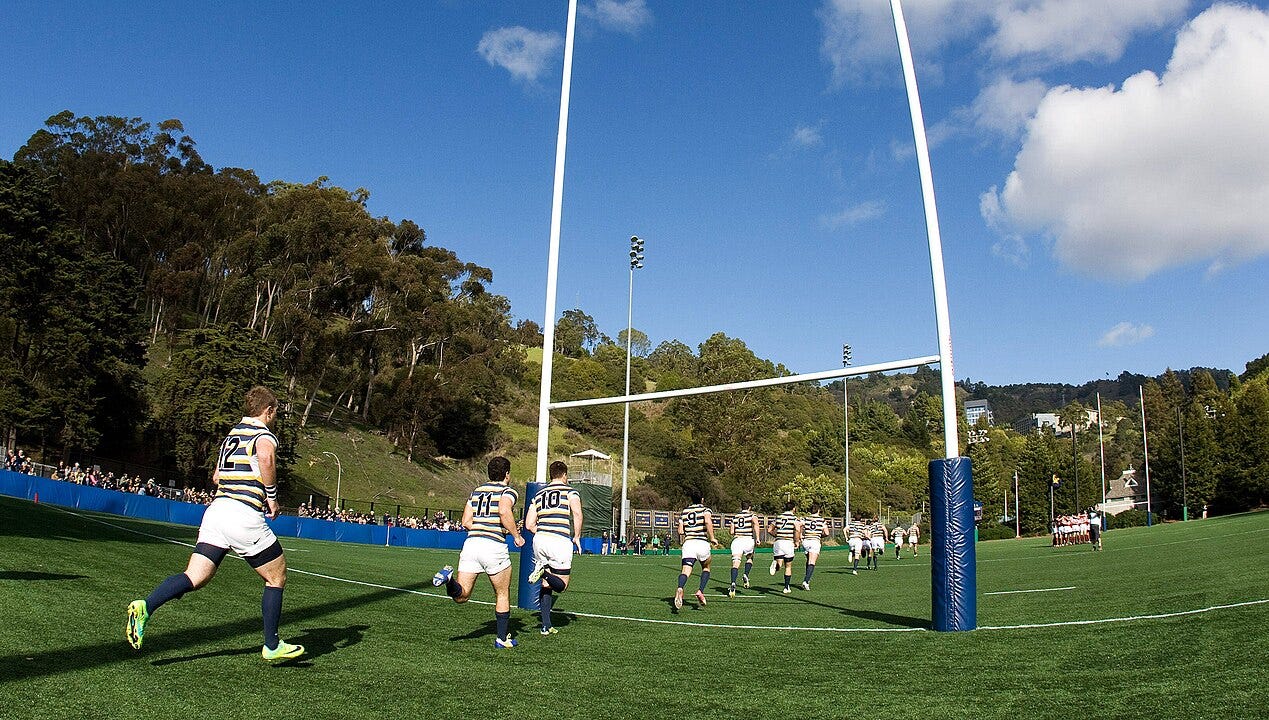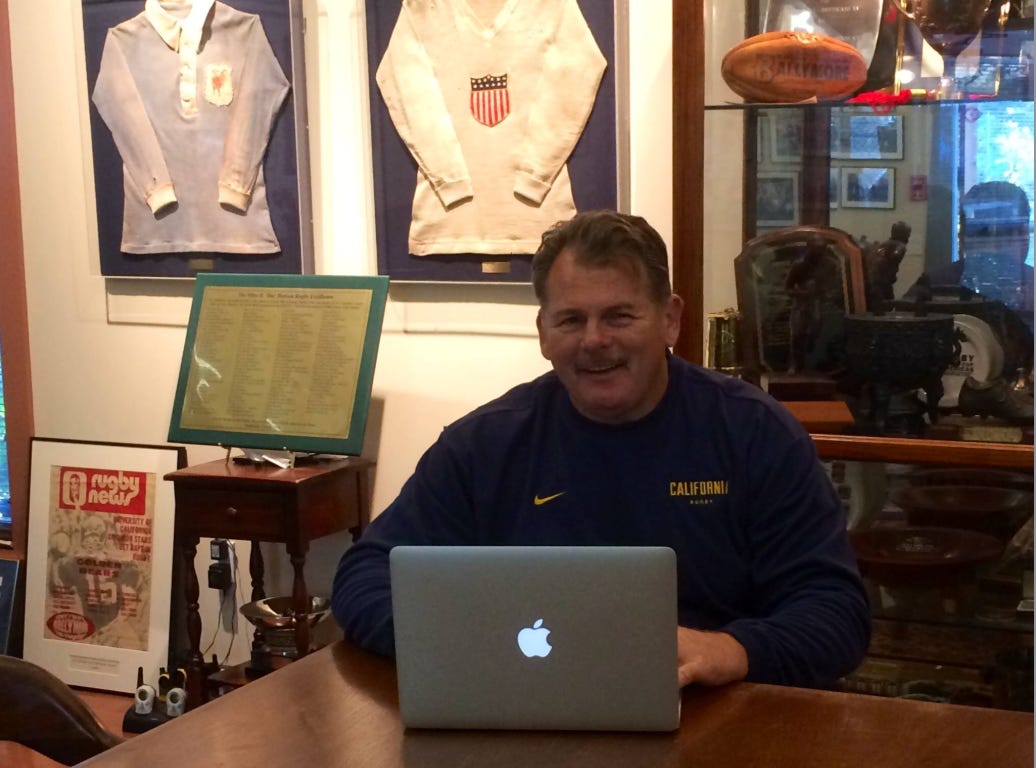Robert Paylor, Cal Berkeley, field houses and club rooms … and the spirit of rugby
The Golden Bears lock turned public speaker has written a book about his battles against tremendous odds. He also writes richly about Cal and the college game

I interviewed Robert Paylor this week, about his new book. It’s called Paralyzed to Powerful: Lessons from a Quadriplegic’s Journey, and it tells Robert’s story before, on and after May 6 2017, the day he played lock forward for Cal Berkeley against Arkansas State in the Varsity Cup final.
In the opening minutes, live on NBCSN, the Golden Bears drove a maul towards the Red Wolves’ line. On the page, Robert describes what happened next:
A player from Arkansas State wrapp[ed] his arm around my neck, putting me in a headlock, and driving my skull into the ground.
Robert’s neck was broken. His book, co-authored with the sportswriter Jason Cole, is a shattering read. Of course it is. But by design, it’s inspirational too. With admirable humor, Robert tells stories including the truly horrifying tale of how hard it is to get a feeding tube up a nose repeatedly broken by rugby. In detail, he describes his arduous recovery, his heartrending challenges and setbacks, his mastery of his anger over how he was injured, how he achieved his dream of graduating from Cal and walking again. How he became a successful public speaker, TED talks online.
Speaking to Robert is a joy. We met, over video, a few days after Cal went to Indianapolis and beat Life, from Georgia, for a 29th national XVs title. That was fitting. Robert’s book should be read to understand his extraordinary story, of course, his resilience and his recovery. My Guardian interview, which will launch next week, will (attempt to) convey that. Here, though, I want to focus on how he also writes fascinatingly and at length about the wider culture of rugby at Cal:
In high school, all I wanted was to go to Cal and play rugby. Every other school that talked to me was a distant second. I came in expecting to grow as a rugby player and student. Then I was introduced to the culture.
That culture has been built by generations of young men striving for excellence since the program’s inception in 1882 as Cal’s first intercollegiate sport. At the time of writing … its record of success includes 11 Olympians, 157 All-Americans, and 60 players who have made 761 combined appearances on the United States National 15s Team. Since 1980, the team has won a total of 33 national championships [including sevens, now 34], and the program has only had six head coaches in its 140-plus years of competition.
You can’t help but feel humbled to be a part of a team of such caliber. That history feeds the larger goal of what [coaches Jack] Clark and [Tom] Billups are continuously working to improve.
The offices of the program are reflective of that dedication to the program’s roots.
The Doc Hudson Memorial Field House at Witter Field is named for one of those head coaches, a New Zealand-born dentist who coached Cal from 1938 to 1974.
Clark and Billups took a small building that used to be a men’s bathroom next to an old, muddy field along the east rim of Cal’s Memorial Stadium and transformed it into a respected place of history. The wood-paneled field house is not just a shrine to the Cal program, but to the game itself. Nearly 100 photos and framed artifacts, including a jersey from the 1924 gold medal-winning USA Olympic team, cover almost every inch of the walls like mosaic tiles.
When you walk in, the phrase Spectemur Agendo [“Let us be judged by our actions”] is directly above the door to the main room of the field house. This isn’t like some locker room with cheesy inspirational phrases all over the place. This is a place where the deeds of the men who came before us are chronicled.
Passages like that, richly evocative, got me thinking about rugby clubhouses and club rooms, and what they mean to the game and those who play it.
I haven’t visited the Cal field house but I have often visited something very like it: Anderson Rugby Complex, at West Point in New York state. The first time I went there, 10 years ago, Mike Mahan, like Clark a giant of college coaching, showed me a sepia photo. He pointed to three players who died young. The rest is published history but the effect of that club room is undiminished each time I walk in.
To adapt Robert’s words about Cal’s home, at West Point “the long room with its bright windows onto the rugby field and the Hudson River is not just a shrine to the Army program, but to the game itself. Photos and framed artifacts, including jerseys and trophies from the national champions of 1967 and 2022, cover almost every inch of the walls.”
In rugby club rooms all over the world, jerseys, trophies, signed balls from great games, programs and other ephemera — at Anderson there’s an inscribed toilet seat, “the Prince Charles throne”, presented by the Royal Air Force — are intensely evocative of the spirit of the club at hand and the game around the world.
Robert’s rich description of the field house at Cal therefore struck me as both familiar and enticingly different. Furthermore, it prompted me to think that relatively few rugby people around the rugby world really know that on either American coast, and in places between, such sacred spaces exist.
The Cal program, with its long history and reel of titles and Eagles, should be better known in London, Dublin and Paris, in Auckland, Pretoria and Sydney. Clark and Billups’ work, as proudly described in Paralyzed to Powerful, should be widely studied. This strikes me particularly hard when I read reports like this one, from Australia this week, that speak of the much-debated future of the American game without much sign of knowing of its rich and relevant past.
I also find it vaguely amusing to put Robert’s loving descriptions of the facilities at Cal, and the dedication it takes to thrive there, next to my memories of my time playing college rugby at Durham in north-eastern England.
I was a second row too. Granted, I was never a 1st XV regular, and in my years at Durham the 1sts didn’t get close to national titles won before and since. We took our game seriously, but not with anything close to the dedication Paylor describes.
Nor did we have a club room to match Army or Cal — or even a club room at all. We changed in the cricket pavilion then ran to play on the Racecourse, a gorgeous field by the River Wear which nonetheless offered just grass touchlines for spectators, of whom there were usually few, half of them dogs on leashes held by history dons. There was a better view the other way: Durham Cathedral, all thousand years of it, looming large to the west.
Of course, plenty of British and Irish colleges with rich rugby traditions do have rooms of their own. I once drank up at Iffley Road, Oxford, after benching for the 1sts in a beating by a Dark Blues team with a couple of Canada internationals in its front row and an Australian giant in its second. I regarded the sepia pictures of Varsity teams past, Heisman winner Pete Dawkins among them, with a sort of resentful awe.
Back to Robert Paylor, and Cal. At the Doc Hudson Memorial Field House,
… there are plenty of trophies on display, but they are secondary to the photos of the players and the memories they forged.
… When you become part of that program, the standard is to compete for championships. However, I found that winning championships is a by-product of something larger and more intricately evolved. The core mission is to shape men of character. Rugby is a vehicle by which that goal is accomplished. What Clark and Billups are doing with the players is an extension of both their personal motivation and their sense of duty to those who came before them.
This motivation has produced an exceptional level of success for its student-athletes, both on and off the field. Cal Rugby has long been a training ground for men who eventually become successful as professionals once their playing days are over.
And therein lies one truth of American rugby: that almost all its finest college players, at Cal, Army, Navy, St Mary’s, Dartmouth, Columbia and everywhere else, men and women both, have long become “professionals once their playing days were over” – leaving college in their early 20s prime to compete in the marketplace, not on the field. Few have continued to become elite rugby players.

All work done to change that is welcome – whether by Major League Rugby and World Rugby or by Super Rugby too, if that report from Australia is to be believed. But after reading Robert Paylor, and talking to him, I think the club room at Cal (or Army) would be a good place to hold first meetings about how to forge a way forward while staying true to the roots of the game.
Further reading:
Robert Paylor Shares His Lessons in `Paralyzed to Powerful', Jeff Faraudo, Sports Illustrated
Miles “Doc” Hudson, US Rugby Foundation
Super Rugby considering USA expansion as World Rugby gets edgy over looming World Cup, Christy Doran, theroar.com.au



